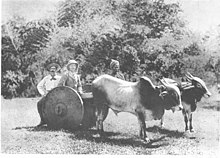George P. Sanderson
George P. Sanderson | |
|---|---|
 Sanderson and Prince Albert Victor in Mysore (1890) on a cart drawn by Amrit Mahal bullocks | |
| Born | 1848 |
| Died | 1892 (Aged 43–44) |
| Occupations |
|
| Notable work |
|
George Peress Sanderson (1848– 5 May 1892, Madras[1]) was a British naturalist who worked in the public works department in the princely state of Mysore. He began a system for capturing wild elephants that were destructive to agriculture so as to use them in captivity. He was known in the popular press as the "Elephant King" and wrote a book on his life in the forests of India. Rudyard Kipling is believed to have modelled the character "Petersen Sahib" in his Toomai of the elephants after him.
Biography
Sanderson was born in

During his employment in the irrigation department of Mysore with the British Government in India he found time for big game hunting which included tigers, elephants and the
Sanderson wrote a book, Thirteen Years Among the Wild Beasts of India,[9][10] based to a large extent on his life at Morlay in the Biligirirangan Hills.[11] He died of pulmonary phthisis in Chennai at the home of his brother-in-law Dr (later Sir) Arthur M. Branfoot in 1892 shortly after marriage and on the way back for a long leave in England.[7][1] An obituary noted that he was a vegetarian[12] while another noted his refusal to accept an invitation to dine with Prince Albert Victor who was visiting Mysore.[13]

An 1899 newspaper correspondent
References
- ^ a b "Death of Mr G.P. Sanderson". The Bombay Gazette. 26 May 1892. p. 5.
- ^ Sanderson (1879):1-2.
- ^ Sanderson, G.P. (1879). Thirteen years among the wild beasts of India. London: W.H.Allen and Co. p. 3.
- ^ "Elephant Catching". Manchester Courier and Lancashire General Advertiser. 20 August 1892. p. 14 – via British Newspaper Archive.
- ^ "A large capture of elephants". Manchester Courier and Lancashire General Advertiser. 25 July 1874. p. 6 – via British Newspaper Archive.
- ^ Smith, A. Mervyn (1904). Sport and Adventure in the Indian Jungle. London: Hurst and Blackett. p. 1.
- ^ a b "Death of the Elephant King". Aberdeen Journal. 18 June 1892. p. 7. Retrieved 1 October 2014 – via British Newspaper Archive.
- ^ Ellison, Bernard C. (1925). H.R.H. The Prince of Wales's Sport in India. London: William Heinemann.
- ^ Sanderson, G. P. (1879). Thirteen years among the wild beasts of India (2nd ed.). W. H. Allen. (1st ed. 1878)
- ^ "Review of Thirteen Years among the Wild Beasts of India by G. P. Sanderson". The Quarterly Journal. 146: 361–384. October 1878.
- ISBN 9780665929854.
- ^ "A mighty hunter dead". Dundee Evening Telegraph. 21 June 1892. p. 2 – via British Newspaper Archive.
- ^ "The Elephant hunter and the prince". Cornubian and Redruth Times. 24 June 1892. p. 6 – via British Newspaper Archive.
- ^ "An Elephant Fight". Otago Witness. 21 September 1899. p. 54.
- ^ Tasker, Sir Theodore (1971). "Petersen sahib". The Kipling Journal. Archived from the original on 20 November 2007.
